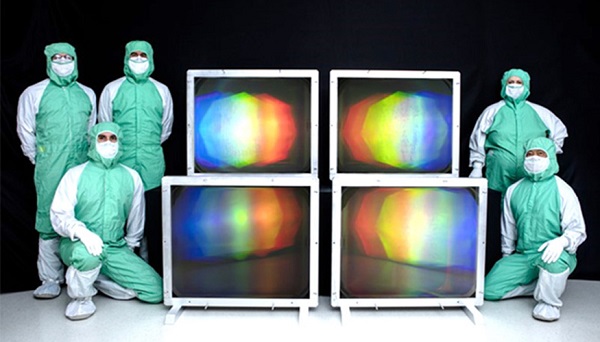Researchers from Lawrence Livermore National Laboratory (LLNL) and their collaborators developed high-energy pulse compression gratings that will be installed in what will be the world’s most powerful laser system. The laser system, called L4-ATON, which is currently being developed, is designed to deliver up to 10 PW of peak power. One petawatt is about 1000× the capacity of the entire U.S. electrical grid.
The high-energy, low-dispersion (HELD) multilayer dielectric gratings will be installed in L4-ATON at the ELI-Beamlines Facility in the Czech Republic. L4-ATON can generate 1.5 kJ of energy in 150-fs pulses, equal to 10 PW of power, at a repetition rate of one shot per minute.

Members of LLNL’s Diffractive Optics Group with four of the 85- × 70-cm HELD gratings to be installed in the ELI-Beamlines L4-ATON laser system. Meter-scale HELD gratings have the potential to facilitate future 20- to 50-PW-class ultrafast laser systems. Courtesy of LLNL.
Multipetawatt laser technology opens the door to research in areas such as plasma and high-energy-density physics, astrophysics, laser-driven particle acceleration, enhanced medical diagnostics, industrial processing techniques, and nuclear materials detection.
The HELD gratings from LLNL deliver 3.4× more total energy than current state-of-the-art technology. They were developed via a collaboration among LLNL’s Diffractive Optics Group, ELI-Beamlines, Spectra Physics-Newport, and National Energetics.
Petawatt and multipetawatt lasers rely on chirped pulse amplification to stretch, amplify, and then compress a high-energy laser pulse to avoid damaging optical components. Pulse-compression gratings must be sufficiently large, efficient, and robust to withstand the high fluence (energy density) of the laser pulses generated by petawatt-class lasers such as the National Ignition Facility’s (NIF) Advanced Radiographic Capability (ARC).

According to LLNL senior laser scientist Hoang Nguyen, the HELD gratings are advancements over the NIF ARC-like gratings and allow for significantly higher energy outputs. The 85- × 70-cm HELD gratings are configured at a Littrow angle (the angle of maximum grating efficiency) of 37º and allow for a larger beamwidth — 62.5 cm. “Increasing the beam height to produce a square beam and accounting for the difference in LIDT (laser-induced damage threshold) results in approximately 3.4× more total energy on the grating compared to the ARC high-dispersion, 76.5º-angle-of-incidence grating design,” Nguyen said.

Multilayer dielectric (MLD) gratings are composed of a base substrate upon which layers of dielectric mirrors with varying refractive indices are stacked, topped by a layer of ion-etched photoresist. MLD gratings can substantially enhance the diffraction efficiency of grating compressors over a large bandwidth or range of frequencies. Unlike the metal used in traditional gratings, dielectric materials are nonconducting and can absorb 500× less energy than previous designs. Courtesy of LLNL.
In addition, the uniformity of the HELD is due to a design with high efficiency over a large range of groove widths and heights and well-controlled dielectric layer thickness, according to Huang. Operating at the grating’s Littrow angle results in maximum diffraction efficiency and bandwidth but requires tilting the angle of the gratings so that the beam reflects slightly upward, or out of plane.